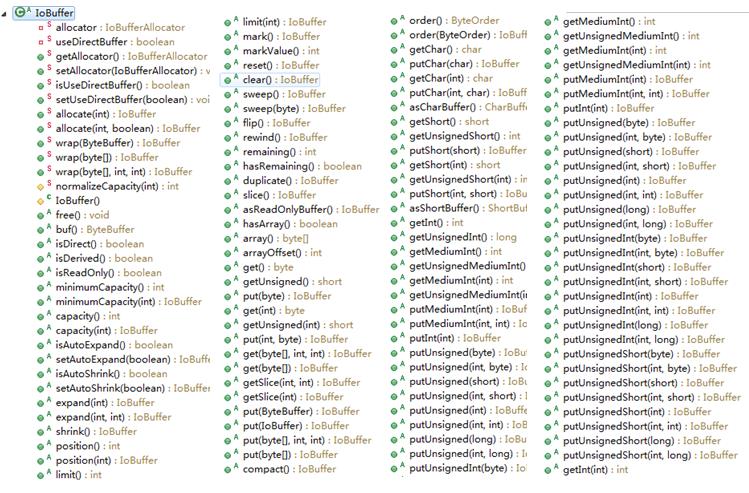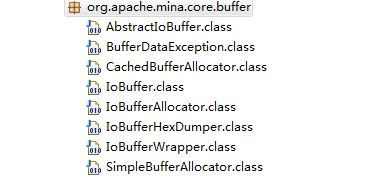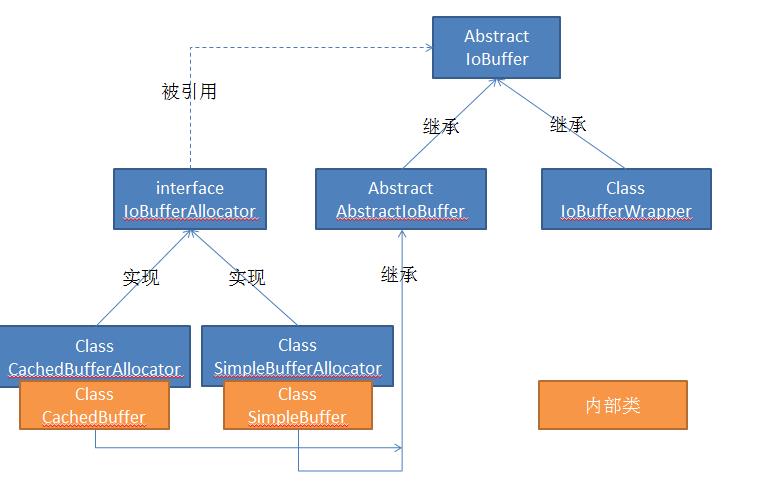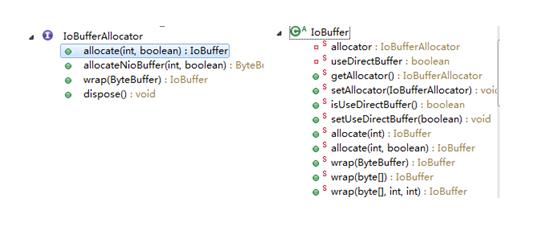MINA系列学习-IoBuffer
在阅读IoBuffer源码之前,我们先看Mina对IoBuffer的描述:A byte buffer used by MINA applications. This is a replacement for ByteBuffer. 这是一个对ByteBuffer的replacement,同样是用作缓冲区,做内容的切换和承载的容器,为什么要用重新封装ByteBuffer,MINA是这么给出解释的Two Reasons:
l It doesn't provide useful getters and putters
l It is difficult to write variable-length data due to its fixed capacity
用过ByteBuffer的人可能经常会遇到BufferOverflowException这样的异常,原因是buffer在初始化allocate之后就不能再自动的改变大小了,如果项目很规整,约定的很好,那可能不太会出意外,怕就怕项目一大,好多东西就乱套了。所以在阅读IoBuffer源码的时候,我们会着重看它和ByteBuffer之间的差异。另外一点,就是IoBuffer作为一个应用框架的工具,必然会提供比原生Buffer更便捷的方法,比如IoBuffer中可以直接put和get String,可以直接将内容转成十六进制等等。
用法很简单,我倒是想从如何将一个已有的类进行封装和扩展的角度来看IoBuffer的源码。在看MINA的源码之前,我们有必要稍稍回顾一下ByteBuffer的构成:
ByteBuffer继承了Buffer类,这个继承关系约定了Buffer系列中特定的操作形式(有点儿像指针),limit/position/mark/capacity,以及在遍历中使用的hasRemaining。然后通过两个静态方法来构建出ByteBuffer:
使用Heap空间,堆空间的构造采用申请byte数组:
public static ByteBuffer allocate(int capacity) {
if (capacity < 0)
throw new IllegalArgumentException();
return new HeapByteBuffer(capacity, capacity);
}使用direct memory,这块内存的开辟就比较麻烦了,好多都是采用了Bit和native的方法:
public static ByteBuffer allocateDirect(int capacity) {
return new DirectByteBuffer(capacity);
}除了构造之外,剩下的主要是对数据的操作方法,wrap、get和put,下面的图没有截全,还有好多方法:

IoBuffer及其相关的类均在org.apache.mina.core.buffer下,IoBuffer定义了buffer使用的规则,AbseractIoBuffer提供了具体的实现:

IoBuffer没有继承任何类,只是实现了comparable接口,我们注意到IoBuffer类修饰符用的是abstract,跟ByteBuffer也是用abstract修饰,至于为什么要用abstract,我觉得也容易理解,毕竟这是一个要对外直接使用的类,同时需要对实现进行规则和扩展:
public abstract class IoBuffer implements Comparable<IoBuffer>在IoBuffer的一系列代码阅读中,你可以看到抽象类之间的继承,内部类的使用情况等等,后面,我会通过一个删减版的例子来盘点这中间的关系,所以大片的源码就不贴了。

UML工具不会用,关键是怕用错了,还是用PPT画了。囧一个,大家有好那种可以一键生成的工具推荐一下,我之前用的是JUDE和Visio。上图画出了IoBuffer中几个重要类之间的关系,两个内部类均继承了AbstractIoBuffer,AbstractIoBuffer和IoBufferWrapper均实现了IoBuffer中的具体操作部分。IoBufferAllocator接口主要定义了为缓冲区开辟空间的方法,所以IoBuffer中需要引用来自IoBufferAllocator的对象。
在IoBuffer中,我们熟知的allocate和wrap方法被声明成了static,通过引用IoBufferAllocator接口中的对象来实现,而其他诸如get、put等操作的方法都定义为abstract了,让其子类得以实现。IoBuffer中我们还值得关注的主要见我之前写过的一篇文章《IoBuffer和ByteBuffer》。
下面是这些中产生buffer的接口IoBufferAllocator和其实现类:

接口很简单,就定义了几个在IoBuffer中已经被static修饰的方法。有两个类都实现了IoBufferAllocator,但是在IoBuffer中使用的是SimpleBufferAllocator:
/** The allocator used to create new buffers */
private static IoBufferAllocator allocator = new SimpleBufferAllocator();
/** A flag indicating which type of buffer we are using : heap or direct */
private static boolean useDirectBuffer = false;所以我们主要关注SimpleBufferAllocator:
public IoBuffer allocate(int capacity, boolean direct) {
return wrap(allocateNioBuffer(capacity, direct));
}
public ByteBuffer allocateNioBuffer(int capacity, boolean direct) {
ByteBuffer nioBuffer;
if (direct) {
nioBuffer = ByteBuffer.allocateDirect(capacity);
} else {
nioBuffer = ByteBuffer.allocate(capacity);
}
return nioBuffer;
}
public IoBuffer wrap(ByteBuffer nioBuffer) {
return new SimpleBuffer(nioBuffer);
}
public void dispose() {
// Do nothing
}这是接口中定义的几个方法,这里调用内部类SimpleBuffer来生成相应的buffer,又由于SimpleBuffer继承了AbstractIoBuffer,所以真正实现的代码在AbstractIoBuffer中(这里有点儿绕,大家结合上面的图和源码一起读)。而且注意构造方法的protected关键字的使用:
private ByteBuffer buf;
protected SimpleBuffer(ByteBuffer buf) {
super(SimpleBufferAllocator.this, buf.capacity());
this.buf = buf;
buf.order(ByteOrder.BIG_ENDIAN);
}
protected SimpleBuffer(SimpleBuffer parent, ByteBuffer buf) {
super(parent);
this.buf = buf;
}看到了吧,底层还是用的NIO中的ByteBuffer。至于怎么实现AutoExpand这样的方法,我觉得不是源码的重点,这些都是算法上的事情,如果你不关注算法,可以稍稍看看即可,而且好多都是native的实现,也看不到。而我这边主要关注的还是他们之间的结构。
上图左边的路走通了,我们来走右边的路,右边主要看AbstractIoBuffer,他是IoBuffer的具体实现,但是它也是一个抽象类,也要被其他类继承,用于扩展。AbstractIoBuffer中,大多类都是final的。而且这里面主要的实现都是在处理limit/position/mark/capacity这之间的关系。而CachedBufferAllocator主要用于实现IoBuffer中自动扩展AutoExpand和收缩: that caches the buffers which are likely to be reused during auto-expansion of the buffers.
----------------------------------------------------------
最后,我们将上面的叙述用一个删减版的代码来模拟一下,这样有助于理解代码的结构,以后遇到类似的情况就可以类似的处理,我更希望,能在分析完所有源码之后,就能呈现一个类似的框架出来,不过这个真的只是想想,毕竟没那么多时间,如果你有时间,可以试着去阉割一下mina。
首先是IoBuffer:
package org.apache.mina.core.rewrite.buffer;
/**
* IoBuffer
*
* @author ChenHui
*
*/
public abstract class IoBuffer {
private static IoBufferAllocator allocator=new SimpleBufferAllocator();
private static boolean direct;
protected IoBuffer() {
// do nothing
}
public static IoBuffer allocate(int capacity) {
return allocator.allocate(capacity, direct);
}
public static IoBuffer wrap(byte[] byteArray, int offset, int length){
//TODO
return null;
}
public abstract IoBuffer get();
public abstract IoBuffer put(byte b);
public abstract boolean other();
}然后是他的继承:
package org.apache.mina.core.rewrite.buffer;
import java.nio.ByteBuffer;
/**
*
* @author ChenHui
*
*/
public abstract class AbstractIoBuffer extends IoBuffer{
protected AbstractIoBuffer(ByteBuffer buffer){
//TODO
}
@Override
public IoBuffer get() {
// TODO Auto-generated method stub
return null;
}
@Override
public IoBuffer put(byte b) {
// TODO Auto-generated method stub
return null;
}
}allocator:
package org.apache.mina.core.rewrite.buffer;
import java.nio.ByteBuffer;
/**
*
* @author ChenHui
*
*/
public interface IoBufferAllocator {
IoBuffer allocate(int capacity, boolean direct);
IoBuffer wrap(ByteBuffer nioBuffer);
ByteBuffer allocateNioBuffer(int capacity, boolean direct);
void dispose();
}allocator的实现:
package org.apache.mina.core.rewrite.buffer;
import java.nio.ByteBuffer;
/**
*
* @author ChenHui
*
*/
public class SimpleBufferAllocator implements IoBufferAllocator{
@Override
public IoBuffer allocate(int capacity, boolean direct) {
return wrap(allocateNioBuffer(capacity, direct));
}
@Override
public IoBuffer wrap(ByteBuffer nioBuffer) {
return new SimpleBuffer(nioBuffer);
}
@Override
public ByteBuffer allocateNioBuffer(int capacity, boolean direct) {
ByteBuffer nioBuffer;
if (direct) {
nioBuffer = ByteBuffer.allocateDirect(capacity);
} else {
nioBuffer = ByteBuffer.allocate(capacity);
}
return nioBuffer;
}
@Override
public void dispose() {
// TODO Auto-generated method stub
}
private class SimpleBuffer extends AbstractIoBuffer{
@SuppressWarnings("unused")
ByteBuffer buffer;
protected SimpleBuffer(ByteBuffer buffer){
super(buffer);
this.buffer=buffer;
}
@Override
public boolean other() {
// TODO Auto-generated method stub
return false;
}
/**这里重写是为了打印方便*/
@Override
public String toString() {
System.out.println(buffer);
return super.toString();
}
}
}最后是测试类和测试结果:
package org.apache.mina.core.rewrite.buffer;
public class Test {
public static void main(String[] args) {
IoBuffer buffer=IoBuffer.allocate(1024);
System.out.println(buffer);
}
}控制台输出:
java.nio.HeapByteBuffer[pos=0 lim=1024 cap=1024]
org.apache.mina.core.rewrite.buffer.SimpleBufferAllocator$SimpleBuffer@1da12fc0-------------------------------------------------------------------
文章引自---https://my.oschina.net/ielts0909/blog/90584
MINA系列学习-IoBuffer的更多相关文章
- Mina的IoBuffer改造成Netty的ByteBuff
背景:部标GPS通讯底层全部改造成基于Netty服务器实现的,现将Mina的依赖移除,修改过程中有用到缓冲区的读写.现做了如下修改: 原有基于Mina的IoBuffer对字节读写封装代码如下: pac ...
- MINA系列学习-mina整体介绍
今天的这一节,将从整体上对mina的源代码进行把握,网上已经有好多关于mina源码的阅读笔记,但好多都是列举了一下每个接口或者类的方法.我倒是想从mina源码的结构和功能上对这个框架进行剖析.源码的阅 ...
- MINA系列学习-IoAccpetor
其实在mina的源码中,IoService可以总结成五部分service责任.Processor线程处理.handler处理器.接收器和连接器,分别对应着IoService.IoProcessor.I ...
- 【MINA】缓存区ByteBuffer和IOBuffer你要了解的常用知识
mina中IOBuffer是Nio中ByteBuffer的衍生类,主要是解决Bytebuffer的两个不足 1.没有提供足够灵活的get/putXXX方法 2.它容量固定,难以写入可变长度的数据 特点 ...
- Mina源码阅读笔记(二)- IoBuffer的封装
在阅读IoBuffer源码之前,我们先看Mina对IoBuffer的描述:A byte buffer used by MINA applications. This is a replacement ...
- Mina、Netty、Twisted一起学(四):定制自己的协议
在前面的博文中,介绍一些消息分割的方案,以及MINA.Netty.Twisted针对这些方案提供的相关API.例如MINA的TextLineCodecFactory.PrefixedStringCod ...
- mina2
远程通信 Mina2 学习笔记 作者:李少华 邮箱:xiaosanshaoli@126.com QQ:305409913 2010-12-23 初稿 引言... 1 一. Mina ...
- mina IoBuffer
mina IoBuffer 常用方法 Limit(int) 如果position>limit, position = limit,如果mark>limit, 重置mark Mark() ...
- mina IoBuffer 常用方法
Limit(int) 如果position>limit, position = limit,如果mark>limit, 重置mark Mark() 取当前的position的快照标记mar ...
随机推荐
- 从ICassFactory为CLSID为{17BCA6E8-A950-497E-B2F9-AF6AA475916F}的COM组件创建实例失败问题解决方法
从ICassFactory为CLSID为{17BCA6E8-A950-497E-B2F9-AF6AA475916F}的COM组件创建实例失败,原因是出现以下错误:c001f011.(Microsoft ...
- 批量Clip
没有建立对应dataset,直接生成featureclass,主要是工作中没几个dataset. # -*- coding: utf-8 -*-__author__ = 'tanshuai' impo ...
- core python applications
第三章: 3.4 电子邮件 SMTP, POP 和 IMAP 协议 第五章: 5.1~5.3 tkinter 各种控件简介 Listbox
- AX7: Install a deployable package
Table of Contents Introduction Key concepts Collect topology configuration data Generate a runbook f ...
- Aptana插件安装方法
本人用的是Zend Studio10.0,在开发项目过程中,发现该软件无法对css和js进行代码提示,这样用起来很不方便,然后在网上找了一下Aptana插件 进入Aptana官网:http://www ...
- 【c++】虚基类
何要使用虚基类: 为何避免多层继承中出项多个公共基类所造成的歧义现象 虚基类用法 派生类继承基类时,加上一个virtual关键词则为虚拟基类继承. 在上图程序运行中,我们发现class bass的构造 ...
- maven使用阿里云仓库
1.修改maven的conf/settings.xml文件,在<mirrors></mirrors>标签里加入: <mirror> <id>nexus- ...
- C#中有哪些类型的数组
一维数组(Single-Dimensional)多维数组(Multidimensional)交错数组(Jagged arrays):交错数组是元素为数组的数组.交错数组元素的维度和大小可以不同.交错数 ...
- 发现大量的TIME_WAIT解决办法
存在一定的TIME_WAIT是正常的,个人认为如果超过了连接数的比例就不是很正常 服务器端与客户端建立TCP/IP连接后关闭SOCKET后,服务器端连接的端口状态变为TIME_WAIT.主动关闭的一方 ...
- 安装Maven
下载进入官网下载页面:http://maven.apache.org/download.html我用的是windows,下载apache-maven-3.2.5-bin.zip: Maven 3.2. ...
